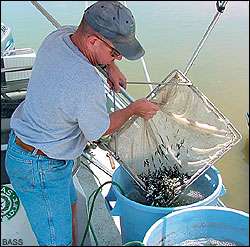
Resource managers restocked Brazos River impoundments Possum Kingdom, Granbury, and Whitney with Florida-strain bass this spring, hoping to soon make them viable fisheries again. They continued to monitor other reservoirs in central and west Texas, ready to replenish them as well, when conditions allowed.
An outbreak of golden algae is what made many Texas waters unsafe — for fish, at least — this past winter. It killed millions in more than a half dozen waters, and continued to kill well into March. Fortunately, humans, mammals, birds, and aquatic insects are immune to the toxic effects of this floating plant that gives the water a yellowish tint.
A toxin from the algae suffocates fish, with filter feeders the first casualties. Other species follow in short order.
“I have witnessed spotted gar physically leap out of the water to get on the bank, and only go back in when they couldn’t breathe anymore,” says Texas Parks & Wildlife Department’s (TPW) Jack Ralph.
“This is a lose-lose situation for us,” says Roger McCabe, a regional director in Waco for TPW. “If we don’t stock, people scream. If we do stock and the fish die, people scream. But the bottom line is that we owe it to anglers to restock as soon as we think it’s safe.”
This past winter’s outbreak in Texas wasn’t the first, and almost certainly won’t be the last. Nor is the Lone Star State the only place where golden algae has killed. It has been found in coastal waters from Israel to Sweden to the Carolinas, as well as the inland waters of New Mexico, Colorado, Nebraska, Kansas, and Wyoming.
“There’s more unknown than known,” says McCabe. “And this is such a huge problem in scope that when we do figure out what’s going on, the remedies may be unfeasible.”

